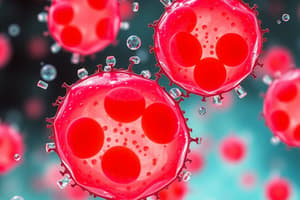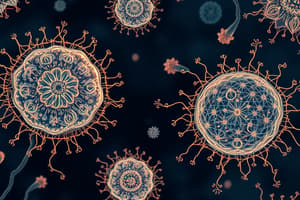Podcast
Questions and Answers
Describe the endosymbiotic theory and how it supports the evolution of eukaryotic cells from prokaryotic ancestors.
Describe the endosymbiotic theory and how it supports the evolution of eukaryotic cells from prokaryotic ancestors.
The endosymbiotic theory posits that certain organelles, like mitochondria and chloroplasts, were once free-living prokaryotes that were engulfed by a larger cell. Over time, they formed a symbiotic relationship, with the host cell providing protection and the engulfed cell providing energy. This is supported by the fact that mitochondria and cholorplasts have their own DNA and ribosomes, similar to bacteria.
Contrast the mechanisms of energy production in prokaryotic cells under aerobic and anaerobic conditions.
Contrast the mechanisms of energy production in prokaryotic cells under aerobic and anaerobic conditions.
Under aerobic conditions, prokaryotic cells utilize cellular respiration, a process that involves the Krebs cycle and electron transport chain to generate ATP. Under anaerobic conditions, prokaryotic cells use fermentation, which produces less ATP and results in byproducts like lactic acid or ethanol.
Explain how the structure of a plant cell's chloroplast is related to its function in photosynthesis.
Explain how the structure of a plant cell's chloroplast is related to its function in photosynthesis.
Chloroplasts contain thylakoids, which are stacked into grana to increase surface area for light-dependent reactions. The stroma surrounds the grana and contains enzymes for the light-independent reactions (Calvin cycle), allowing for efficient conversion of light energy into chemical energy.
Describe how binary fission contributes to genetic diversity in prokaryotic populations, and list one other way they can swap genetic information.
Describe how binary fission contributes to genetic diversity in prokaryotic populations, and list one other way they can swap genetic information.
Contrast the energy strategies between heterotrophic fungi cells and autotrophic plant cells. Be specific about the source of energy and how it's used.
Contrast the energy strategies between heterotrophic fungi cells and autotrophic plant cells. Be specific about the source of energy and how it's used.
Flashcards
Cell Theory
Cell Theory
The foundational concept that all living organisms are composed of cells.
Prokaryotic vs Eukaryotic Cells
Prokaryotic vs Eukaryotic Cells
Prokaryotic cells lack a nucleus; eukaryotic cells have a nucleus and organelles.
Mitosis
Mitosis
The process by which eukaryotic cells divide to produce identical daughter cells.
Aerobic vs Anaerobic Energy Production
Aerobic vs Anaerobic Energy Production
Signup and view all the flashcards
Binary Fission
Binary Fission
Signup and view all the flashcards
Study Notes
Cell Theory
- Cells are the fundamental units of life.
- All living things are composed of cells.
- All cells arise from pre-existing cells.
Prokaryotic vs. Eukaryotic Cells
- Prokaryotes: Lack a nucleus and membrane-bound organelles. Bacteria are prokaryotes.
- Eukaryotes: Have a nucleus and membrane-bound organelles. Animals, plants, and fungi are eukaryotes.
Eukaryotic Cell Reproduction (Mitosis)
- Mitosis is a type of cell division that results in two genetically identical daughter cells.
- It's crucial for growth, repair, and asexual reproduction in eukaryotes.
Heterotrophs and Autotrophs
- Heterotrophs: Organisms that obtain energy by consuming other organisms. Animals and many fungi are heterotrophs.
- Autotrophs: Organisms that make their own food through photosynthesis (plants) or chemosynthesis (some bacteria). Plants are autotrophs.
Specialized Structures in Plant, Animal, and Fungi Cells
- Plant cells: Contain a cell wall, chloroplasts (photosynthesis), and large vacuoles.
- Animal cells: Often lack cell walls, have centrioles (cell division), and various specialized organelles.
- Fungi cells: Often have cell walls composed of chitin.
Anaerobic and Aerobic Energy Production in Prokaryotes
- Anaerobic respiration: Energy production without oxygen.
- Aerobic respiration: Energy production using oxygen.
Binary Fission
- Binary fission is the asexual reproduction of prokaryotes. A single cell divides into two identical daughter cells.
Plant Energy Generation
- Plants generate energy through photosynthesis, converting light energy into chemical energy (sugars).
Cell Organelles
- Cell wall: A rigid outer layer that provides support and protection (plant cells).
- Chloroplast: Site of photosynthesis in plant cells.
- Mitochondria: Powerhouses of the cell; site of cellular respiration.
- Vacuoles: Storage compartments for water, nutrients, and waste products, particularly large in plant cells.
- Ribosomes: Sites of protein synthesis.
- Nucleus: Contains the cell's DNA.
- Endoplasmic Reticulum (ER): Network of membranes involved in protein and lipid synthesis and transport.
- Golgi apparatus: Processes, sorts, and packages proteins and lipids for transport.
- Cytoskeleton: A network of protein filaments that gives the cell its shape and facilitates movement.
- Centrioles: Involved in cell division in animal cells.
- Lysosomes: Contain enzymes used for digestion and waste breakdown.
- Plasma membrane: Outer boundary of the cell, controls what enters and exits.
- Nucleolus: Within the nucleus, a region involved in ribosome synthesis.
Studying That Suits You
Use AI to generate personalized quizzes and flashcards to suit your learning preferences.




